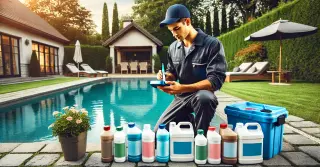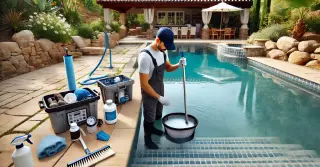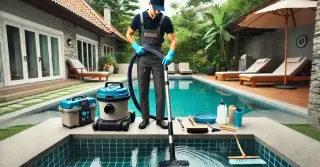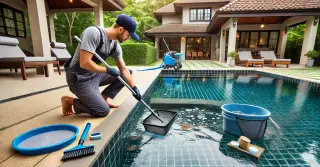Pool Chemical Balance Hillsborough County FL

Maintaining the proper chemical balance is vital for swimmer safety and pool health. Balanced chemicals inhibit algae and bacteria, maintain clear, clean water, and protect the pool's surface and equipment.
- Optimal pH Balance: Your pool's pH level indicates its acidity or alkalinity. Optimal pH levels range from 7.2 to 7.6. Acidic water from low pH can irritate skin and corrode equipment. High pH levels make the water alkaline, leading to cloudiness and scaling. Frequent pH testing and adjustments is essential to maintain a comfortable and safe swimming environment.
- Managing Chlorine Concentration: Chlorine is essential for pool hygiene, as it kills bacteria, algae, and other harmful microorganisms. Optimal chlorine levels range from 1 to 3 ppm. Insufficient chlorine results in unsanitary conditions, promoting bacteria and algae growth. Excessive chlorine leads to skin and eye irritation and produce a strong chlorine odor. Regularly testing and adjusting chlorine levels maintains sanitation and comfort.
Managing Total AlkalinityTotal alkalinity is a crucial element of pool chemistry. Alkalinity acts as a buffer for pH levels, avoiding sudden pH changes. The optimal total alkalinity range is 80-120 ppm.
- Stabilizing pH Levels: Balanced alkalinity stabilizes pH levels, preventing rapid pH changes that irritate skin and damage surfaces. Low alkalinity results in unstable pH levels, making it difficult to maintain a consistent balance. High alkalinity causes cloudy water and scaling. Frequent alkalinity testing and adjustments is crucial for stable and balanced water.
- Calcium Hardness Control: Calcium hardness indicates the calcium level in pool water. Proper calcium hardness levels range from 200 to 400 ppm. Insufficient calcium causes corrosive water, damaging surfaces and equipment. If calcium levels are too high, it can cause scaling on pool surfaces and cloud the water. Frequent calcium hardness testing and adjustments is important for protecting your pool and ensuring clear water.
Safe Handling of Pool ChemicalsHandling and storing pool chemicals properly is vital for safety and chemical performance. Keep chemicals in a cool, dry location, away from direct sunlight and out of reach of children and pets. Always follow the manufacturer's instructions for proper dosing and application.
- Accurate Chemical Measurement and Mixing: Accurately measuring pool chemicals is crucial for maintaining balance. Using too much or too little can disrupt the chemical balance and affect water quality. Always use a clean, dry measuring tool and avoid mixing chemicals directly. Mix chemicals in water if required, following the instructions carefully.
- Awareness of Chemical Reactions: Certain chemicals can react dangerously if mixed. For instance, never mix chlorine and acid. Being aware of these interactions avoids accidents and ensures safe use. Store chemicals apart and handle each carefully to prevent harmful reactions.
Maintaining the proper chemical balance in your pool is essential for a safe, clean, and enjoyable swimming environment. By regularly testing and adjusting pH, chlorine, alkalinity, and calcium levels, you ensure optimal water quality.
Safe use and storage of pool chemicals further ensure the health and safety of your pool and its users.




